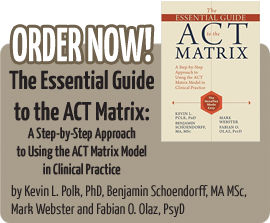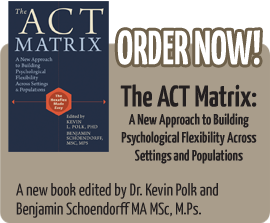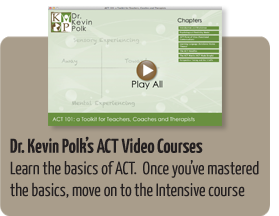Choose something you would like to move toward. That might be a relationship, might be work, and it might be to save the world.
It does not matter for now, you can always choose another something to move toward later. Finding what you are passionate about is like that; it usually takes a few tries before you find something that triggers passion.
We are going to use this diagram to map out the process you are about to go through:
Write who or what you would like to move toward in the lower, right of the diagram.
Now think of a behavior that would move you Toward what you chose. Use simple behaviors like walk, talk, write, etc; a behavior other people could see you doing. Write these in the upper, right of the diagram.
Now imagine doing the behavior. Notice any thoughts or feelings that show up inside of you that might get in the way of doing the Toward behavior. If any come to mind, then write them in the lower, left of the diagram.
Now imagine having the “Away” thoughts and feelings. What do you typically do to move away from such thoughts and feelings? Write those behaviors in the upper, left of the diagram. (Some examples are avoid, watch TV, listen to music, meditate, drink, sleep, etc.)
As you can see, the right side of the diagram is labeled Toward and the left Away. The top part of the diagram has your physical behaviors and your sensory connections to the world (think of your five senses being right at the top of the vertical line). The bottom represents stuff going on inside your skin that others can’t see; so thoughts, feelings and urges go down there.
Next time you get the chance to move Toward, notice if you do a Toward or an Away behavior. Notice what is going on inside and outside of you.
Notice what you learn from this experience.
————————————-
The above instructions came to me as I read some books on learning to play piano and guitar. There are two approaches: One is to learn the basic notes and chords and such, and after awhile (sometimes a long while) you play a song. The other way is to choose a song you would really like to play on the piano or guitar, get the right sheet music for that instrument, and then go about learning how to play that song. Chances are you will eventually learn how to play the song well enough so others can recognize it. You will learn what you need to know about the piano or guitar as you learn to play that song.
ACT can be much the same way. When we teach people ACT we often have them learn the basics with the promise that one day it will all come together for them. The other way is to have someone choose a Value (who or what’s important in Matrix terminology), a Toward move (committed action in ACT lingo) and then notice what happens when the opportunity to do a Toward move shows up.
————————————
If you are coaching someone in using the Matrix, then your aim is to promote psychological flexibility by having your student(s) sort stories (words, phrases, and whole sentences) into the Matrix.
By using the brief exercise above you have started to teach your student to notice the difference between Toward and Away moves AND to notice the difference between outside the skin and inside the skin experiencing.
You are now just a step away from having the student do Sorting into the Matrix.
Have the student tell a Toward or an Away story and have the student sort the story into the Matrix categories (sensory, mental, Toward and Away).
If the person gets stuck and stops sorting, then use Yes…And to draw the student back into sorting and then back to identifying more important stuff and planning more toward moves.
Sorting is very simple. Every word, phrase and story can be sorted into the four basic Matrix categories:
1. Outside (sensory and physical behaviors)
2. Inside (thoughts, emotions, urges, etc.)
3. Toward (either inside or outside behaviors)
4. Away (either inside or outside behaviors).
[Note: The scientific base under ACT treats inside and outside stuff as behaviors.]
Sorting increases psychological flexibility. Try it, you will see what I mean.
There is no right or wrong sorting. Wherever a student sorts a word, phrase or sentence is fine. The aim is increasing psychological flexibility, not accurate sorting.
Sometimes a student’s mind might get in the way and sorting stops. At these times simply say, “Yes…And where would that go in the Matrix?” That usually get sorting started again.
There is no need for a student to sort everything. That would just be weird. After you have presented the Matrix, have natural conversations with your student(s) until you hear some inflexibility show up in the conversation, then have the student sort the inflexible part of the story.
…………………………………………………..
If you need help learning how to coach your students using the Matrix, I offer free and paid training webinars, plus individual consulting via the phone and internet (like Skype). You can sign up for my mailing list by Clicking Here.
The fastest way to become very good at using the Matrix is my Mastering the Matrix Class. Up to six people train with me for up to nine months. The first month is intensive (four small group webinars and two private training sessions. Then 8 months of monthly small group webinars to hone your skills over time. You can reach what is known as Verbal Aikido with this kind of training. That’s the ability to spin most any word, phrase, sentence, story or situation into psychological flexibility in an instant.
The cost of the training and the tote bag would be $900.00 bucks if you bought all the training separately. In this package deal you can get it all for a one-time payment of $397.00 or nine monthly payments of $50.00 (still a huge discount).
To register and pay the one time fee, go Click Here.
To pay over nine months (I will manually register you), Click Here (See the Subscribe button to the right on the web page.)
I look forward to training with you soon.
Kevin
Kevin L. Polk, Ph.D.
email me with any questions by clicking here





Leave a Reply